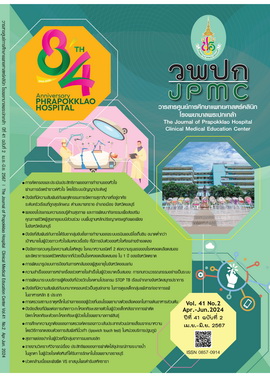ปัจจัยที่มีความสัมพันธ์กับบทบาทครอบครัวเป็นศูนย์กลาง ในการดูแลเด็กกลุ่มแพ้สารก่ออาการแพ้ในอาหารหลัก 8 ประเภท
Main Article Content
บทคัดย่อ
ที่มาของปัญหา: การแพ้อาหาร (food allergy) เป็นกลไกการตอบสนองของภูมิคุ้มกันที่เฉพาะเจาะจงในร่างกาย ต่อโปรตีนบางชนิดในอาหารที่รับประทาน โดยการสร้างแอนติบอดี้ ซึ่งเด็กอายุระหว่าง 5-12 ปี เป็นช่วงอายุที่พบว่าเกิดการแพ้มากที่สุด และกลุ่มอาหารที่ทำให้เกิดอาการแพ้มากที่สุด ได้แก่ อาหารทะเล นมวัว ไข่ แป้งสาลี ทั้งนี้ครอบครัวมีบทบาทสำคัญในการดูแลเด็กแพ้อาหารตั้งแต่แรกเกิด
วัตถุประสงค์: เพื่อศึกษาพฤติกรรมการดูแลสุขภาพของเด็กแพ้อาหารกลุ่ม Top 8 allergies ของครอบครัว และปัจจัยที่มีความสัมพันธ์กับบทบาทของครอบครัวเป็นศูนย์กลางในการดูแลเด็กแพ้อาหารกลุ่ม Top 8 allergies ได้แก่ การรับรู้ความรุนแรงของการแพ้อาหาร การรับรู้ความเสี่ยงของการแพ้อาหาร การรับรู้ระยะเวลาการเจ็บป่วย องค์ประกอบต่างๆ ของโมบายแอปพลิเคชัน บทบาทของครอบครัวในการดูแล เด็กแพ้อาหารกลุ่ม Top 8 allergies
วิธีการศึกษา: การวิจัยครั้งนี้ เป็นการวิจัยแบบตัดขวาง (cross sectional research) เพื่อศึกษาปัจจัยที่มีความสัมพันธ์กับบทบาทครอบครัวเป็นศูนย์กลางในการดูแลเด็กแพ้อาหารกลุ่ม Top 8 allergies กลุ่มตัวอย่างคือครอบครัวที่มีเด็กแพ้อาหาร จำนวน 100 ครอบครัว รวบรวมข้อมูลโดยแบบสอบถามที่ผู้วิจัยสร้างขึ้น ได้แก่ การรับรู้ความรุนแรงของการแพ้อาหาร การรับรู้ความเสี่ยงของการแพ้อาหาร การรับรู้ระยะเวลาการเจ็บป่วย องค์ประกอบต่างๆ ของโมบาย แอปพลิเคชัน และบทบาทของครอบครัวในการดูแลเด็กแพ้อาหารกลุ่ม Top 8 allergies ตามแนวคิดแบบแผนความเชื่อด้านสุขภาพ
ผลการศึกษา: พบว่า คะแนนเฉลี่ย การรับรู้ความเสี่ยงของการแพ้อาหาร ของผู้ดูแลอยู่ในระดับมาก (X̄=21.7) การรับรู้ความรุนแรงของการแพ้อาหารอยู่ในระดับปานกลาง (X̄=17.0) การรับรู้ระยะเวลาเจ็บป่วยอยู่ในระดับปานกลาง (X̄=5.7) องค์ประกอบต่างๆ ของโมบาย แอปพลิเคชัน อยู่ในระดับมาก (X̄=14.8) และบทบาทของครอบครัวที่มีเด็กแพ้อาหารในระดับ มาก (X̄=82.6) ผลวิเคราะห์ค่าสหสัมพันธ์ระหว่างปัจจัยทำนาย มีความสัมพันธ์กับบทบาทของครอบครัว ที่มีเด็กแพ้อาหารหลัก 8 ประเภท สูงสุดคือความต้องการองค์ประกอบต่างๆ ของโมบายแอปพลิเคชัน (r=0.50) และตัวแปรทั้ง 4 ตัวแปร สามารถทำนายบทบาทของครอบครัวในการดูแลเด็กแพ้อาหารได้ ร้อยละ 27.4
สรุป: ผลการวิจัยนี้ เป็นข้อมูลการดูแลเด็กแพ้อาหารของครอบครัว บุคลากรทางสาธารณสุข ควรส่งเสริมการรับรู้ความรุนแรงของการแพ้อาหาร ระยะเวลาของการแพ้อาหารแต่ละประเภท ให้กับครูพยาบาลประจำโรงเรียน ครอบครัวและชุมชน คำแนะนำอาหารที่ควรหลีกเลี่ยงและการช่วยเหลือเบื้องต้น ผ่านโมบายแอปพลิเคชัน
Article Details

This work is licensed under a Creative Commons Attribution-NonCommercial-NoDerivatives 4.0 International License.
References
Bird JA, Lack G, Perry TT. Clinical management of food allergy. J Allergy Clin Immunol Pract 2015;3:1-11.
Alruwaili YS, Hammad SM, Elwan A. Prevalence of allergic rhinitis among female secondary school students, in Arar city, Saudi Arabia. Med Sci 2021;25:363-73
Mahdavinia M. Food allergy in adults: presentations, evaluation, and treatment. Med Clin North Am 2020;104:145-55.
Mahmoud MH, Wahb HMA, Mahmoud MH. Evaluation of a new baby food prepared from Opuntiaficusindica fruit in Wistar rats with either calcium deficient or vitamin A depletion. JAPER 2019;9:101-8.
Patel N, Herbert L, Green TD. The emotional, social, and financial burden of food allergies on children and their families. Allergy Asthma Proc 2017;38:88-91.
Meyer R. Nutritional disorders resulting from food allergy in children. Pediatr Allergy Immunol 2018;29:689-704.
Loh W, Tang MLK. The epidemiology of food allergy in the global context. Int J Environ Res Public Health [Internet]. 2018 [cited 2022 Oct 10];15(9):2043. Available from: https://www.ncbi.nlm.nih.gov/pmc/articles/PMC6163515/pdf/ijerph-15-02043.pdf
Sampath V, Sindher SB, Alvarez Pinzon AM, Nadeau KC. Can food allergy be cured? what are the future prospects?. Allergy 2020;75:1316-26.
Nookong A. Food allergies in children: more dangerous than you think [Internet]. 2023 [cited 2023 Nov 17]. Available from: https://www.nstda.or.th/sci2pub/food-allergies-in-children/
Mookachonpan D. Regulations of food allergies. For Quality Journal 2009;114:69-71.
Lao-araya M, Trakultivakorn M. Prevalence of food allergy among preschool children in northern Thailand. PediatrInt 2012;54:238-43.
Janz NK, Becker MH. The health belief model: a decade later. Health Educ Q 1984;11:1-47.
Jongudomkarn D. Family health nursing: theoretical concepts and application in times of family crisis. 4th ed.KhonKaen: Faculty of Nursing, KhonKaen University; 2021.
Suratanont N. Food allergy management in child care center and school: practical guidelines. In: Suphapeetiporn K, Chongsrisawat V, Deekajorndech T, Chatrproedprai S, Sosothikul D, Rianthavorn P, et al, editors. Interprofessional Team Care in Pediatrics: Learn and Work Together. Bangkok: Chulalongkorn University; 2021. p.14-21.
Faul F, Erdfelder E, Lang AG, Buchner A. G*Power 3: a flexible statistical power analysis program for the social, behavioral, and biomedical sciences. Behav Res Methods 2007;39:175-91.
Keller SP, Kelvin EA. Munro’s statistical methods for health care research. 6th ed. Philadelphia: Lippincott Williams & Wilkins; 2013.
Sriratanaban J, Witvorapong N, Woratanarat T, Ngamkiatphaisan S, Wimuttichai V, O-charot L, et al. The preparedness and responses of the health services system to the COVID-19 crisis in Thailand: hospital operation and economic and social impacts within the boundary of the health services system [Internet]. 2021 [cited2022 Oct 10]. Available from: https://kb.hsri.or.th/dspace/handle/11228/5391
Pichaitum S. The association between family factors and parenting style and nutrional status among grade4-6 students in schools under the office of the basic education commission in Muang district [dissertation]. Phitsanulok: Naresuan University; 2019.
Yamcharoen J, Tangsatjatam P. Family Relationship Support Application by using Mobile and Social Network Technology. In: Proceedings of the7thAcademic Science and Technology Conference; 2019 Jun 7; PathumThani, Thailand. p.1646-58.
Leaungsomnapa Y, Samroumram P, Pimtara P, Micor T, Prasong D, Klangjai T, et al. The effectiveness of using mobile application improving the perception of dopamine drug administration skill among nursing students. J Prapokklao Hosp Clin Med Educat Center 2020;37:134-43.
